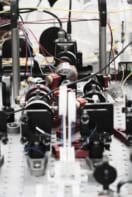2015 is the International Year of Light and Light-based Technology (IYL 2015), as people around the world celebrate the remarkable properties of light and its applications. In this short film you will meet people working in some of the key focus areas of IYL 2015, including Nobel laureates, development professionals and a range of people from the creative industries.
“The year of light is a chance to focus on some of the amazing things that we’ve learned about light and using light. But more importantly, about some of the amazing opportunities we have to learn new things about light,” says William Phillips, who won the 1997 Nobel Prize in Physics for developing methods to cool and trap atoms with laser light.
These interviews were filmed earlier this month during the official opening ceremony of IYL 2015 at UNESCO’s headquarters in Paris. This two-day event – attended by more than 1000 people – combined talks with exhibitions, art installations and musical performances. The event opened with the reading of a statement from the UN secretary general Ban Ki-moon who said that “light is a unifying symbol that signifies wisdom and excites the imagination across the world”.
One of the key activities of IYL 2015 is to highlight the use of light-based technologies for global development. For instance, the Study after Sunset initiative is promoting the use of solar-powered LED lanterns in parts of the world where there is little or no reliable source of light for after dark. Linda Wamune, a development worker featuring in this film, says there are currently 600 million kerosene lamps being used in Africa. These are expensive to fuel and the fumes they emit can be extremely damaging to people’s health, but people use them because of the absence of reliable electricity grids.
Another key strand of IYL 2015 is to build bridges between the sciences, arts and humanities through collaborative projects. As an example of the scope and diversity of the international year, the film features the adventurer and speleologist called Olivier Testa, who was involved in assembling a special collection of photographs of the caves of Haiti. These images demonstrate how light and shadow can reveal the geological richness of these environments in stunning detail.
Stay tuned to physicsworld.com throughout IYL 2015 for plenty more light-inspired films. In the meantime, don’t forget to check out our free-to-read digital collection of 10 of the best Physics World features related to the science and technology of light, spanning everything from the physics of rainbows to a new type of glasses that could bring improved vision to millions.


